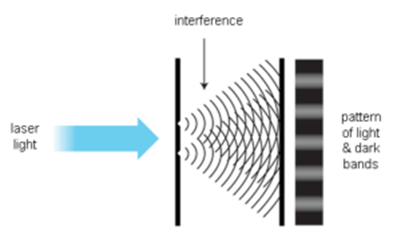
The interfering fringes formed by a thin oil film on water are seen in the yellow light of sodium lamp. We find the fringes
(A) Colored
(B) Black and white
(C) Yellow and black
(D) Colored white yellow
Answer
222.9k+ views
Hint: When light waves undergo interference, the intensity gets redistributed forming bright and dark fringes. These fringes are formed without changing the frequency of the waves. As we know that the frequency of the light wave is the determinant factor for the color, so this means that the color of the light wave will remain constant.
Complete step-by-step solution
During interference, the waves from two coherent sources superpose on each other and the resultant wave has its intensity redistributed which is viewed as bright and dark fringes. During this interference process only the intensity is getting redistributed but the frequency of the light waves remains the same. This is the reason why yellow light from sodium lamps is seen after interference as well.

The light waves under constructive interference form yellow fringes as bright fringes and under destructive interference the black fringes are formed as dark fringes.
Hence, the correct option above is C.
Note: Constructive interference occurs when crest of one wave falls one crest of the other, has phase difference of 0 or 2n \[\pi \] and path difference n $\lambda $ and destructive interference occurs when crest of one wave falls on trough of other, has phase difference of \[\left( {2n + 1} \right)\pi \] and path difference $(2n - 1)\dfrac{\lambda }{2}$ .
Complete step-by-step solution
During interference, the waves from two coherent sources superpose on each other and the resultant wave has its intensity redistributed which is viewed as bright and dark fringes. During this interference process only the intensity is getting redistributed but the frequency of the light waves remains the same. This is the reason why yellow light from sodium lamps is seen after interference as well.

The light waves under constructive interference form yellow fringes as bright fringes and under destructive interference the black fringes are formed as dark fringes.
Hence, the correct option above is C.
Note: Constructive interference occurs when crest of one wave falls one crest of the other, has phase difference of 0 or 2n \[\pi \] and path difference n $\lambda $ and destructive interference occurs when crest of one wave falls on trough of other, has phase difference of \[\left( {2n + 1} \right)\pi \] and path difference $(2n - 1)\dfrac{\lambda }{2}$ .
Recently Updated Pages
JEE General Topics in Chemistry Important Concepts and Tips

JEE Extractive Metallurgy Important Concepts and Tips for Exam Preparation

JEE Atomic Structure and Chemical Bonding important Concepts and Tips

JEE Amino Acids and Peptides Important Concepts and Tips for Exam Preparation

Electricity and Magnetism Explained: Key Concepts & Applications

JEE Energetics Important Concepts and Tips for Exam Preparation

Trending doubts
JEE Main 2026: Application Form Open, Exam Dates, Syllabus, Eligibility & Question Papers

Derivation of Equation of Trajectory Explained for Students

Hybridisation in Chemistry – Concept, Types & Applications

Understanding the Angle of Deviation in a Prism

How to Convert a Galvanometer into an Ammeter or Voltmeter

Degree of Dissociation: Meaning, Formula, Calculation & Uses

Other Pages
JEE Advanced Marks vs Ranks 2025: Understanding Category-wise Qualifying Marks and Previous Year Cut-offs

Dual Nature of Radiation and Matter Class 12 Physics Chapter 11 CBSE Notes - 2025-26

Ideal and Non-Ideal Solutions Explained for Class 12 Chemistry

Understanding the Electric Field of a Uniformly Charged Ring

Understanding Atomic Structure for Beginners

Understanding Electromagnetic Waves and Their Importance




